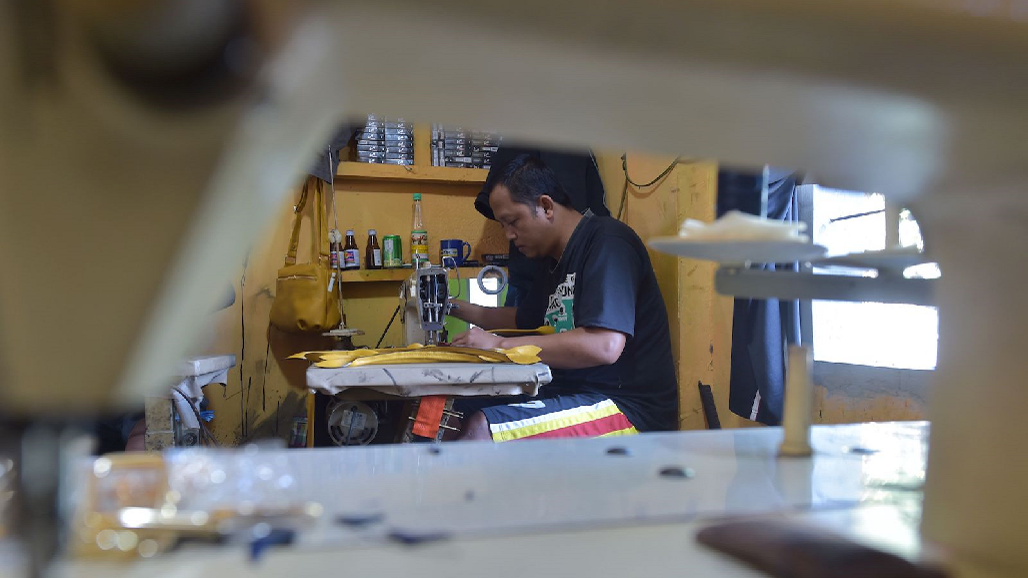Photo by Adek Berry/AFP/Getty Images
(Photo: A man works at a leather factory in West Java. The financing gap in Indonesia, especially for MSMEs (micro, small and medium enterprises), is as large as $75 billion.)
Note: This is the second article in a special series focusing on topics related to fintech.
 Jakarta – In late 2015, when I first presented my business plan to a group of financial professionals in Indonesia, it was met with strong skepticism and apathy. “Do you understand Indonesian borrowers? They will default on you,” or “Are you sure OJK (the regulator) will support this?” were common refrains. The journey to launch a digital-financing platform seemed treacherous back then.
Jakarta – In late 2015, when I first presented my business plan to a group of financial professionals in Indonesia, it was met with strong skepticism and apathy. “Do you understand Indonesian borrowers? They will default on you,” or “Are you sure OJK (the regulator) will support this?” were common refrains. The journey to launch a digital-financing platform seemed treacherous back then.
Fast forward three years, the Indonesian P2P lending industry is now a billion-dollar industry, having disbursed an estimated $1 billion since 2016. Over the same period, more than two million borrowers (companies and individuals) and 150,000 lenders have also been served by the industry.
The rapid growth of P2P lending has led to investments by reputable global and local investors, such as Sequoia Capital, SoftBank and Mandiri Capital. This has been no mean feat, given the numerous regulatory, risk management and growth challenges the industry has faced along the way.
Launching a Digital-Financing Platform Without Regulation
 Launching a digital financing platform in 2016 was simple; there were no regulations to comply with or industry standards to follow. No regulations may sound like a good thing for a startup, yet countries that waited longer to regulate P2P lending, such as China, have seen difficult outcomes for the industry. In the case of China, years without regulations have meant that it is not uncommon to see platforms shut down due to fraud and poor risk management, taking investors’ money down with them. While regulation is easily perceived as anti-growth, basic regulations related to consumer protection and risk management can, in fact, play an enabling role as it fosters the sustainability of the industry.
Launching a digital financing platform in 2016 was simple; there were no regulations to comply with or industry standards to follow. No regulations may sound like a good thing for a startup, yet countries that waited longer to regulate P2P lending, such as China, have seen difficult outcomes for the industry. In the case of China, years without regulations have meant that it is not uncommon to see platforms shut down due to fraud and poor risk management, taking investors’ money down with them. While regulation is easily perceived as anti-growth, basic regulations related to consumer protection and risk management can, in fact, play an enabling role as it fosters the sustainability of the industry.
As a fintech platform, there are benefits to spending time at the start engaging with the financial services regulator and government institutions, while educating the public and media. The message is clear and consistent: Fintech is the answer to financial inclusion, yet fintech will only thrive under a balanced set of regulations. Recognizing the need to regulate, in late 2016, Indonesia’s Financial Services Authority announced its first set of regulations for fintech, which has since set a solid foundation for the digital financing industry.
Navigating the Risks of SME Financing
The financing gap in Indonesia, especially for MSMEs (micro, small and medium enterprises), is as large as $75 billion. Yet, serving small businesses is often challenging from a risk-management standpoint. The majority of Indonesian SMEs have limited or poor financial management practices and limited or no credit history, making it difficult to underwrite credit. Solving such a challenge is not straightforward, with different companies adopting different approaches.
The first school of thought is about leveraging data and technology in the most impactful way possible. By using alternative data provided by loan applicants, such as online transactions and mobile-use behaviors, it is possible to discern through the quality of the loan applicants. It is equally important to have the methodology and habit to conduct tests, measurements and iterations on a regular basis on various underwriting approaches to determine the optimal methods. Putting technology, data and disciplined testing together, it is possible to navigate risk-management challenges so as to serve more SMEs.
The second school of thought could be called the “bank-plus” approach. In short, the bank-plus approach is about adapting a credit underwriting approach that has worked well at banks and adjusting parts of it to make it work for the underserved market. Adjustments could include changes to the product design or the replacement of specific document or loan requirements, without compromising on risk management. Such an approach works well especially when the financing arrangement is larger and more complicated and where a more robust assessment approach is still the most reliable. Under this situation, it is still imperative to review traditional information and data, such as bank statements and invoices, to approve credit for SMEs.

Scaling to $1 Billion
One would think that in a country where smartphone penetration is high, marketing to SMEs would not be difficult, but that is not the case in Indonesia. Reaching $1 billion was a three-year journey filled with challenges and surprises. One of our more surprising findings was that, despite the penetration of smartphones, most small-business owners are not savvy users of the pocket machine. The fact that the majority also have a weak or basic understanding of financial literacy exacerbates the problem. So how does one scale a startup when most of the potential users are not easily accessible?
Part of the answer lies in partnerships, a channel that seems to be working out quite well for industry players. It is possible to have collaborations with e-commerce and payments platforms to deliver financing to merchants, leveraging transaction information on these platforms. In addition, there are opportunities to work with traditional supply chains, leveraging their networks and track records to serve SMEs operating in their distribution channels and managing risk by using data and technology. Such partnerships allow fintech startups to reach a wider audience while keeping credit risk manageable.
Yet, partnerships are only one part of the puzzle. In a new industry like ours, branding has also been instrumental to startups’ ability to scale. Most of Modalku’s lenders, for example, come organically to our mobile and web platforms, and compared to our initial days, most of our borrowers now know Modalku before they even come to us, influencing their decision to borrow. This was made possible through constant engagement with the public and media, including publishing and distributing relevant content on a regular basis.
Realizing Financial Inclusion
Despite the rapid growth of the industry, there is still a long way to go in achieving greater financial inclusion. After all, with $1 billion of loans disbursed, P2P lending has only closed a tiny part of the $75 billion financing gap that exists in Indonesia. Credit data infrastructure remains weak, and SMEs—which are spread across various islands of Indonesia—remain largely weak in managing finances professionally and are less-than-savvy users of technology.
This, in turn, implies continued challenges and potential opportunities for startups in this space. To move forward, fintech companies are increasingly investing more into market education, product development, and credit assessment technologies. With the backing of a supportive regulator, major technology investors, and a slowly maturing industry, it will only be a matter of time before we see the industry reach a new high for financial inclusion.
Related themes: Investment Regulation Risk Mitigation
 Iwan Kurniawan
Iwan Kurniawan
Co-founder and COO of Modalku
Iwan Kurniawan is the co-founder and COO of Modalku, Indonesia’s leading marketplace lending platform for small business financing. Prior to Modalku, Mr. Kurniawan was a management consultant with global consulting firm Oliver Wyman, covering Southeast Asia and China.
This article was published in the Brink Asia’s website.


Leave a Reply